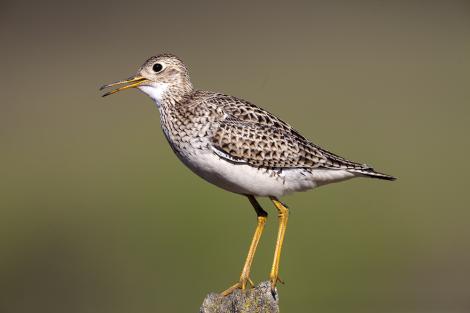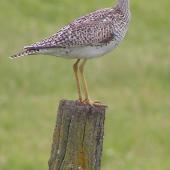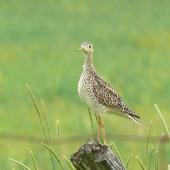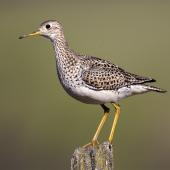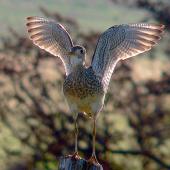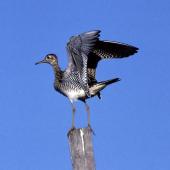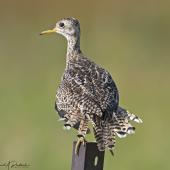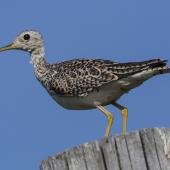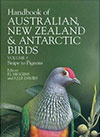Upland sandpiper
Bartramia longicauda (Bechstein, 1811)
Order: Charadriiformes
Family: Scolopacidae
Geographical variation: Nil
The upland sandpiper is essentially a small, short- and straight-billed curlew in behaviour and habitat. It breeds on grasslands in North America and winters in similar habitats throughout South America. It is a very rare vagrant to New Zealand, with a single record from the Manukau Harbour in 1967.
Identification
The upland sandpiper is warm-brownish streaked medium-sized wader with an erect stance. It has a small pigeon-like head, large dark eye on an unmarked buffy face, long neck and a disproportionately long, barred tail. The underparts are white with dark brown chevrons on the breast merging into barring on the flanks. The underwings are barred black-and-white, and are often held extended up when the bird lands, particularly on elevated perches (e.g. fence posts) on its breeding grounds. The upperwings are plain brown, with darker primaries (no wingbar). The bill is straight and yellowish, and the legs long and greenish-yellow. The Tringa-like upright posture; small, bland-looking head and straight, thin bill are characteristic of upland sandpiper. In New Zealand, upland sandpiper should be looked for in similar habitats as Pacific golden plover.
Voice: whistles usually heard only on breeding grounds.
Similar species: the buff-breasted sandpiper (not yet recorded from New Zealand, but multiple records from Australia) is chunkier, with shorter, brighter yellow legs, and shorter bill and tail, as well as having bright white underwings. Little whimbrel has a striped head, down-curved bill, dark legs and shorter tail. Pacific golden plover has a larger head, thicker, darker bill, shorter tail and plain underwings. Ruff has longer, darker bill, smaller eye, shorter tail, lacks chevrons and barring on its underparts, and has a plain white underwing.
Distribution and habitat
This American species occurs in the Pacific only as a rare vagrant. Although its preferred habitat is grasslands, a wide variety of grassland types is utilised.
Population
The overall population of upland sandpiper is stable, and is estimated at around 350,000 birds.
New Zealand records
The only New Zealand record was a single bird at Karaka, Manukau Harbour, in February 1967. The only other record from the western Pacific is a specimen taken near Sydney in 1848 and now in the Australian Museum.
Threats and conservation
In its native range, the main threat to upland sandpipers is conversion of grasslands to livestock and grain production.
Websites
References
Heather, B.D.; Robertson, H.A. 1996. The field guide to the birds of New Zealand. Viking, Auckland.
Higgins, P.J.; Davies, S.J.J.F. (eds.) 1996. Handbook of Australian, New Zealand and Antarctic birds. Vol. 3, snipe to pigeons. Oxford University Press, Melbourne.
Houston, C.S.; Jackson, C.R.; Bowen, D.E. Jr 2011. Upland sandpiper (Bartramia longicauda), The Birds of North America Online (A. Poole, ed.). Ithaca: Cornell Lab of Ornithology.
McKenzie, H.R. 1968. Suspected upland plover (Bartramia longicauda) in Manukau Harbour. Notornis 15: 216-218.
Recommended citation
Silcock, R. 2013. Upland sandpiper in Miskelly, C.M. (ed.) New Zealand Birds Online. www.nzbirdsonline.org.nz
Upland sandpiper
- Breeding season
-
- Jul
- Aug
- Sep
- Oct
- Nov
- Dec
- Jan
- Feb
- Mar
- Apr
- May
- Jun
- Egg laying dates
-
- Jul
- Aug
- Sep
- Oct
- Nov
- Dec
- Jan
- Feb
- Mar
- Apr
- May
- Jun




